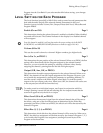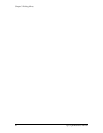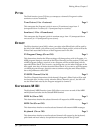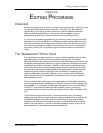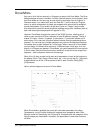
Chapter 6: Editing Programs
HOW THE QS GENERATES SOUND
The QS uses custom integrated circuits, developed by the Alesis engineering team
specifically for the QS. These resemble the types of chips used in computers and
other digital devices. In fact, you can think of the QS as a special-purpose computer
designed to generate and process audio. Although the user interface maintains the
metaphor of “modules,” in fact all sounds are simply a set of numbers reflecting how
you’ve programmed the various sound parameters. For example, when you change
the filter cutoff frequency, you’re not actually messing with a filter; you’re telling the
computer to simulate the effect of messing with a filter.
Each “module” is represented by parameters that appear on one or more display
pages. The [s VALUE]/[VALUE t] buttons and the CONTROLLER [D] slider let you
change these parameters. All “patching” is done via software, so the only patch cords
you need are those that go to your mixer or amplifier.
You can take a “snapshot” of the QS’s parameters and save this in memory as a
program. The QS comes with 512 factory preset programs, and 128 user-editable
programs.
PROGRAM SOUND LAYERS
The simplest method of programming is to take one voice, process it through the filter
and amp sections, and (if desired) add some effect to it. However, more elaborate
Programs usually consist of 2 to 4 layers, with each layer making its own distinct
contribution to the sound, for example:
• An organ program with Program Sound 1 set to a sustained organ waveform, and
Program Sound 2 set to a percussion waveform with a fast decay.
• A piano program with one layer tuned normally, and a second layer tuned an
octave higher.
• A synthesizer program with one layer set to a sharp attack waveform, a second
layer set to an acoustic waveform, and a third layer with a slow-attack string
waveform.
This may remind you of Mix Play Mode, where playing the keyboard can sound up to
16 different Programs at once. There are many similarities. In Mix Play Mode, you
can make the same kind of layered Mix as you can with the four sounds of a
Program. But there are differences:
Use Program Layers:
• If you want multiple sounds to respond to a single MIDI channel. For example, if
you need to play a layered synthesizer sound that was assembled in Mix Play
Mode instead of Program Play Mode, you must send 3 Note On messages from
your sequencer (one for each channel) for every note; a layered program would
need only one Note On message.
• When layers of a Program are designed to be used together, and the individual
layers by themselves wouldn't be used alone (for example, the percussion layer
of the organ sound).
Use Mix Play Mode:
48 QS7/QS8 Reference Manual



